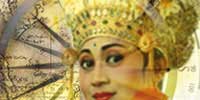|
JAKARTA (Indo.com): Under the stunning heat, a young fair-skin
lady in red opened a worn-out wooden box and a few moments
later dozens of cheerful small birds flew to the sky, seeking
a nearby tree on which they could perch. The relief-looking
lady gazed at the blue sky, watching the flying birds. "Thanks
God," she murmured.
The lady was one of the visitors who came to Chinese Temple,
Jinde Yuan, now called Vihara Dharma Bhakti, to say a prayer.
The release of the birds, which in Chinese is called fangsheng
is part of the Chinese religious activities. "It represents
an actualization of love," visiting worshipper David B.
Susatyo told Indo.com. "According to our belief,
all living creatures deserve love. So, those who help release
any shackled living creature will get rewards from God,"
he added.
The temple has been seeing an increasing number of worshippers
over the last several months following the government move
to revoke the 1967 regulation banning any celebration of
Chinese cultural and religious events. "With the government
new policy, more Chinese worshippers come to the temple
and pray without the feeling of fear or restraint as they
used to. And as an expression of gratitude, more worshippers
release birds," David said.
In the past, kelenteng was not recognized as a place
of worship. "Under the New Order regime, followers of the
Chinese religion could not conduct their religious activities
freely. They were in a state of insecurity but now the country
is conducive to the religious activities," he said.
Through Presidential Decree No. 6, 2000, Pesident Abdurrahman
'Gus Dur' Wahid announced the revocation of the 1967 regulation
on January 18, 2000. Under the decree, Chinese Indonesians
who want to express various aspects of their beliefs, culture,
and their original traditions are no longer required to
ask special permit from the government.
Visitors who come to the Temple are not confined to believers
of Chinese religion covering Confucian, Buddhism and Taoism.
"Visitors also include tourists, historians and researchers
from China, Korea, Japan, the United States, German, England
and the Netherlands. The temple is open to all, irrespective
of differences of religion, ethnicity and race," he said.
Jakarta is a home to some 140 Chinese temples, some of them
dating back to 1650s and declared protected buildings. Jinde
Yuan and Da-bo-gong in the Ancol recreational part in North
Jakarta are the two oldest extant temples in the capital.
Jinde Yuan temple considered the largest one in town is
located on Jl. Petak Sembilan in West Jakarta. The kelenteng,
a common term for Chinese temples throughout Java, stands
firmly among the houses erected on a densely populated area
and gives a bright look to the surroundings with its yellow
and red ornaments. With a name meaning "Temple of Golden
Virtue", it was built in 1755 by a Chinese Kapitein,
a Dutch term for Captain given to Chinese leaders in the
Dutch East Indies.
Basically, the temple covers three teachings, namely Confucianism,
Taoism and Buddhism. "Kelenteng is an embodiment
of the three teachings. This is unique because it covers
three teachings that complement each other," David said.
Worshippers with burning incense stick will start praying
in front of an altar for the Almighty God, the Creator,
before entering the temple.
The smell of incense mingles with acrid odor of burning
candles and 'hio' or incense stick greet you when
you enter through the door of the main building.
Inside the temple above the main door, there is an effigy
of the Sanguan Dadi or the "Emperors of the Three Realms
-Heaven, Earth and Water" who is portrayed as three officials,
all of the same size, wearing dark-colored costumes and
headdresses.
In the center of the main building, the statue of Guanyin,
placed inside a glass case, accompanied by statues of the
three Buddhas at its back, which symbolizes a kind of Buddhist
Trinity.
Eighteen statues of Shibo Luohan, the worthy followers of
Buddha, nine on the left side and nine on the other, guard
those deities. There is also QianShou Guanyin, Guanyin portrayed
as having thousand arms.
The statues of other deities are placed in the left and
the right wings outside the main building.
People never cease entering the temple from its opening
at 5 a.m. to 7 p.m. when it closes. Around 500 people beseech
the deities each day. The number may reach over 1000 during
special events like the eve of coming of Sin Cia or the
Chinese New Year and the birthday of Guanyin which falls
on the 19th of the 6th lunar month.
People praise the deities for several reasons. For example,
they may be seeking safety, prosperity, fertility and so
on. One of the most adorable deities is Guanyin or the so-called
Goddess of Mercy. The statue of this main deity is placed
on the main altar in the center of the building.
Temple Da-bo-gong Miao in the Ancol recreational park in
North Jakarta is said to be unique because Muslims, including
native Indonesians, also visit there. The building has been
restored several times, with the current structure dating
from around the 18th century, historian Adolf Heuken was
quoted by the Jakarta Post as saying.
Unlike other temples, the names engraved beneath the statues
of the Da-bo-gong's deities are not Chinese, as one might
expect, but Indonesian --- Ibu Sitiwati, Ibu Enneng, Ibu
Mone and Embah Said Areli Dato Kembang.
Both Muslims and Chinese people visited the temple because
"it is a kelenteng ( Chinese temple) but at the same
time a kramat (sacred place) to Muslims," Heuken
wrote in his book Historical Sites in Jakarta.
If the lady in red released the birds in front of kelenteng,
let's say five years ago, she might not have been able to
do it as freely as she does now.
|







